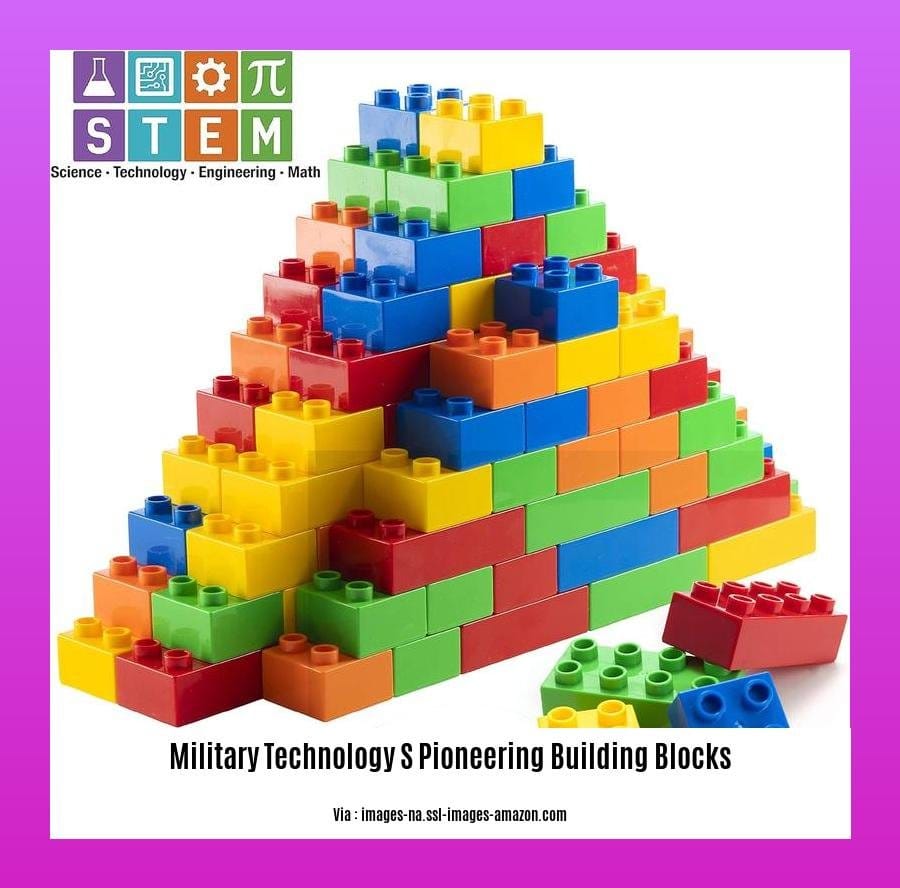Dive into the uncharted depths of military technology and unearth the groundbreaking building blocks shaping the future of warfare in [Unveiling Military Technology’s Pioneering Building Blocks]. From the genesis of pioneering inventions to their profound impact on modern combat, we delve into the intricacies of technologies that have revolutionized the battlefield.
Key Takeaways:

- Technological advancements enhance military capabilities and drive investments in electronic systems.
- Modular building systems expedite the construction of military bases.
- Historical building blocks inspire realistic training simulations.
- Historical building blocks provide educational insights into military history.
- Innovation in military technology relies on dedicated research and development communities.
Military Technology’s Pioneering Building Blocks
As we delve into the realm of military technology, it becomes evident that the advancements we witness today are the product of foundational building blocks established long ago. These pioneering elements have paved the way for the sophisticated systems and strategies that dominate modern warfare.
Modular Building Systems: Rapid Assembly for Military Bases
Modular building systems have revolutionized the construction of military bases. These prefabricated components enable rapid assembly, providing temporary shelter or permanent structures in remote or harsh environments. Their versatility and efficiency have proven invaluable in supporting troops and operations worldwide.
Historical Building Blocks: Realistic Military Training Simulations
World War II-inspired building blocks have found a unique purpose in military training. These blocks, meticulously designed for accuracy and detail, allow soldiers to create realistic simulations of battlefield scenarios. By constructing and maneuvering these blocks, they gain invaluable experience and enhance their tactical decision-making skills.
Landing Craft Building Blocks: Educational and Historical Value
Landing craft building blocks offer a unique blend of historical accuracy and educational value. These blocks enable hobbyists and enthusiasts to construct replicas of iconic landing craft used in military operations. By studying their design and functionality, one can gain a deeper understanding of the challenges and triumphs of amphibious warfare.
Research and Development (R&D) Communities: Innovation Hubs
Military technology innovation is driven by the tireless efforts of research and development (R&D) communities. These dedicated groups of scientists, engineers, and strategists are constantly pushing the boundaries of military capabilities. Through their collaborations and experimentation, they lay the groundwork for the next generation of game-changing technologies.
Conclusion
Military technology’s pioneering building blocks represent the cornerstone of modern warfare. These foundational elements have enabled rapid advancements, from modular construction to realistic training simulations, and have shaped the way we approach defense and security. By recognizing and understanding these building blocks, we can better appreciate the complexity and evolution of military technology, and its impact on the world we live in.
Ever wondered what innovations were used in the military? We have developed a list of pioneering innovations with defense capabilities by innovators whose work had military applications. This list includes dual-use civilian and military innovations that have had a significant impact on both the military and civilian worlds.
Nuclear Weapons: A Cornerstone of Strategic Deterrence
The modernization of America’s nuclear arsenal is a vital endeavor, as affirmed by the 2022 Nuclear Posture Review. This comprehensive effort encompasses upgrades to delivery systems, warheads, and command and control capabilities.
Upgrading Warheads and Delivery Systems
The Department of Energy oversees warhead modernization, while the Pentagon manages nuclear weapons delivery systems. The goal is to ensure the reliability, safety, and effectiveness of our nuclear deterrent.
Adapting to Evolving Threats
The proliferation of new technologies is challenging traditional deterrence methods. To maintain credibility, the United States must adapt by enhancing its ability to respond to a range of threats.
Key Takeaways:
- Modernizing the nuclear arsenal is crucial for strategic deterrence.
- Warhead and delivery system upgrades are integral to this effort.
- The evolution of new technologies necessitates adaptation in deterrence strategies.
Citation:
- US Department of Defense:
Aircraft Carriers: The Cornerstone of Maritime Dominance
Aircraft carriers have been the lynchpin of naval warfare for decades, serving as floating airbases that project power across vast distances. These behemoths of the sea have revolutionized naval combat, enabling swift and decisive strikes from the heart of the ocean.
History and Evolution
Aircraft carriers trace their roots back to the early 20th century, when navies realized the potential of aircraft in maritime warfare. Initially converted from existing ships, modern aircraft carriers are purpose-built marvels of engineering, boasting extensive flight decks, hangars, and support facilities.
Design and Capabilities
Aircraft carriers are colossal vessels, typically displacing over 100,000 tons. Their vast flight decks can accommodate a variety of aircraft, including fixed-wing fighters, bombers, and helicopters. Below the flight deck lie hangars and workshops where aircraft are maintained and repaired.
The propulsion systems of aircraft carriers enable them to reach speeds of up to 30 knots, allowing them to keep pace with naval task forces. They also feature advanced sensors, radar systems, and defensive capabilities to protect against threats.
Role in Modern Warfare
Aircraft carriers play a multifaceted role in modern warfare. They provide:
- Air Superiority: Aircraft carriers can launch fighter jets to establish and maintain air dominance, neutralizing enemy aircraft and suppressing ground targets.
- Power Projection: The ability to deploy aircraft from the sea allows aircraft carriers to strike deep into enemy territory without the need for land bases.
- Force Projection: Aircraft carriers can serve as platforms for amphibious operations, launching helicopters and landing craft to transport troops and equipment ashore.
Key Takeaways:
- Aircraft carriers have transformed naval warfare, providing unparalleled air power projection.
- These massive vessels are designed with advanced flight decks, hangars, and propulsion systems.
- Aircraft carriers play a vital role in air superiority, power projection, and force projection in modern warfare.
Citation:
- Aircraft Carrier – Naval Technology
Submarines
Key Takeaways:
- The U.S. Navy remains steadfast in prioritizing the production of Submarines.
- The Navy has contracted nine Block V Virginia-Class Submarines with deliveries between 2025 and 2029.
- Additional funding of $50 million is crucial to maintain Virginia-Class Submarine production schedules.
- The Navy’s commitment to Submarines underscores their importance in maintaining strategic deterrence.
Context:
In a rapidly evolving landscape, where stealth, payload capacity, and cutting-edge technology reign supreme, the U.S. Navy is doubling down on the construction of Submarines. As the backbone of America’s undersea fleet, these vessels epitomize the relentless pursuit of innovation and strategic advantage.
The Navy’s unwavering focus on Submarines is a testament to their unparalleled capabilities. Block V Virginia-Class Submarines are the next wave of undersea dominance, boasting a larger payload capacity and enhanced stealth capabilities. These advancements will propel the Navy into the future, ensuring the U.S. remains a formidable force beneath the waves.
However, maintaining the Navy’s Submarine superiority requires a robust industrial base. The Navy’s recent request for $50 million in additional funding highlights the critical need to keep construction on schedule following disruptions caused by the COVID-19 pandemic.
In this era of strategic uncertainty, Submarines have become more than just warships; they are symbols of America’s unwavering commitment to safeguarding its interests in the vast expanse of the world’s oceans. They are the silent guardians, the protectors of national security, and the cornerstone of a navy that stands ready to meet any challenge.
Citation:

FAQ
Q1: What factors have driven advancements in military technology?
A1: Technological advancements, including modular building systems and electronic system investments, have contributed to improved tactical advantages.
Q2: How do World War II-inspired building blocks play a role in modern military training?
A2: These building blocks provide realistic simulations, enhancing the accuracy of training exercises.
Q3: What is the significance of R&D communities in military technology innovation?
A3: Research and development communities are crucial for developing and refining cutting-edge military technologies.
Q4: Why is the modernization of the U.S. nuclear arsenal a priority?
A4: To maintain strategic deterrence in the face of evolving technological threats.
Q5: What are the key features of the Virginia-Class Block V submarines?
A5: These submarines feature enhanced stealth capabilities, a larger payload capacity, and construction innovations.
- Unlocking Francis Alexander Shields’ Finance Empire: A Comprehensive Biography - July 12, 2025
- Unveiling Francis Alexander Shields: A Business Legacy - July 12, 2025
- Francis Alexander Shields’ Business Career: A Comprehensive Overview - July 12, 2025















